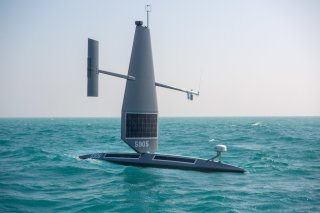Why the Navy’s Unmanned Surface Vessels Are Making a Splash
They excel at high-endurance surveillance and reconnaissance—and Iran is taking notice.
An Iranian warship seized a pair of U.S. Navy unmanned surface vessels operating in the Red Sea as part of the 5th Fleet. The incident comes just two days after the Iranian Navy tried to seize a similar unmanned surface vessel in a separate incident in the Arabian Gulf.
In a statement, the U.S. Navy said that the two vessels were “unarmed and taking unclassified photos of the surrounding environment while loitering in an assigned patrol area at least four nautical miles from the nearest maritime traffic lane. The vessels posed no risk to naval traffic and had been operating in the general vicinity of the Southern Red Sea for more than 200 consecutive days without incident.”
The Navy's statement added further details, explaining that “at around 2 p.m. (local time) on Sept. 1, U.S. 5th Fleet detected the Iranian ship approaching both unmanned vessels and removing them from the water. U.S. Navy guided-missile destroyers USS Nitze (DDG 94) and USS Delbert D. Black (DDG 119) were operating nearby and immediately responded. Nitze and Delbert D. Black also each launched an MH-60R Sea Hawk from Helicopter Maritime Strike Squadron 48.”
“Nitze and Delbert D. Black remained on scene communicating with the Iranian warship to deescalate the situation and recover the seized Saildrones. The Iranian warship released the Saildrones at 8 a.m. on Sept. 2," it continued.
According to a report from the Associated Press, the Iranians covered the unmanned vessels with tarps and initially denied that they had seized them. Though the Iranians eventually returned the vessels, they were missing cameras, according to a U.S. Navy official who spoke on the condition of anonymity.
The unmanned surface vessels themselves are a unique piece of U.S. Navy equipment. Built by Saildrone, the vessel is powered entirely by wind and solar power—made possible by a large sail appendage and an array of solar panels that provide power to various onboard sensors.
Though the vessels can perform several meteorological and maritime data collection-type mission profiles, they also lend themselves well to extremely long endurance reconnaissance and surveillance—precisely the kind of mission the U.S. Navy is carrying out with their vessels.
Though an unmanned surface vessel’s advantages are clear, the vessels could, in particular, excel in the world’s largest ocean—the Pacific. Referred to as the Indo-Pacific in American military parlance, enormous distances between landmasses mean that having a persistent set of eyes and ears constantly at sea would be a distinct advantage.
Caleb Larson is a multimedia journalist and defense writer with the National Interest. A graduate of UCLA, he also holds a Master of Public Policy and lives in Berlin. He covers the intersection of conflict, security, and technology, focusing on American foreign policy, European security, and German society for both print and radio. Follow him on Twitter @calebmlarson
Image: DVIDS

